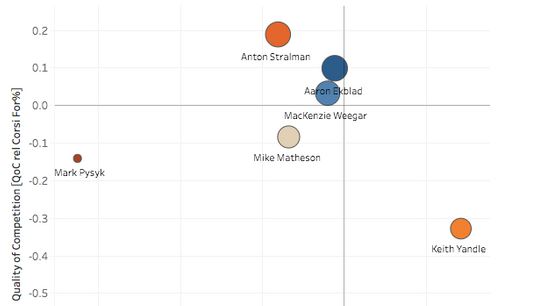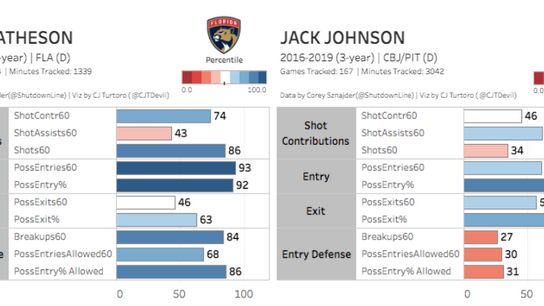The Penguins on Thursday sent Patric Hornqvist to the Panthers in exchange for defenseman Mike Matheson and forward Colton Sceviour
We'll take a look at both pieces the Penguins acquired in the trade, starting with Matheson. What kind of a player did the Penguins get? Here's a look.
MIKE MATHESON
Position: Defenseman
Height: 6-2
Weight: 192
Age: 26
Shoots: Left
SCOUTING REPORT
Jim Rutherford called Matheson "a young, skilled defenseman with great offensive instincts who plays with speed and has a good shot."
Matheson is a decently-sized, puck-moving defenseman, and moves up into the play enough that, for a couple games in February, Florida coach Joel Quenneville played Matheson as a forward.
"He's up in the play," Quenneville said Feb. 11. "He's got some speed and he's got the puck a lot. I think (Matheson and defenseman Mark Pysyk) know how to sustain and hang onto the puck in the offensive zone."
Matheson's career-best season offensively was 2017-18, when he produced 10 goals and 17 assists in 81 games. Matheson played 59 games in the coronavirus-shortened 2019-20 season, missing just over two weeks due to injury early in the season and missing a few games as a healthy scratch later on. He still produced offensively at roughly the same rate, scoring eight goals and 12 assists in those 59 games.
Matheson's decision-making can be questionable at times, though, and can lead to him being out of position or turning the puck over. And while he's on the bigger side physically, he doesn't have much of a physical element to his game.
ANALYTICS
What do the numbers tell us? First, let's get some context for how the Panthers used Matheson this past season.
Matheson played 59 games for the Panthers this season, going anywhere from a healthy scratch to the top pairing alongside Aaron Ekblad at times. Both Matheson and Pysyk also played several games in the second half of the season at forward.
This visualization from Dobber Sports, which draws data from Natural Stat Trick, shows how the Panthers' seven most frequently used defensemen were deployed.

Players higher up on the chart were deployed against better competition (like opposing teams' top lines), and the further left a player reflects how often a player began a shift in his own zone. In Matheson's case, he's right in the middle of the group. The quality of competition he faced had a relative shot attempt differential just under even, and 46.63 percent of his starts came in the offensive zone.
Matheson also was seldom utilized on the power play. He played just 14:15 on the power play in the entire regular season, with Keith Yandle and Ekblad taking most of the power-play time. He did kill penalties fairly regularly, with 71:52 of short-handed time in the regular season.
Given the Penguins' current makeup on the blue line, Matheson projects as a bottom-pairing defenseman. And given that Matheson is left-handed, it would seem like he could be competing with Jack Johnson for his job, rather than make one of the two play on their off side. So it's worth comparing the two defensemen in this case.
This visualization comes from the A3Z Player Comparison tool, which collects data from a select number of games each season. This chart shows averages for the past three seasons prior to 2019-20:

When it comes to creating offense, this shows that Matheson takes more shots himself, but Johnson assists on more shots. Matheson has many more offensive zone entries with possession than Johnson, but Johnson has more defensive zone exits with possession. The biggest difference between the two based on this data is in the rate of zone entry breakups, of which Matheson records at a much higher rate.
Matheson is more of a puck-moving defenseman and can help in creating offense. Johnson is better at getting his team out of his own zone, but Matheson is better at preventing play from entering team's zone in the first place.
As noted, Matheson's decision-making can be poor at times. He had the second-highest rate of giveaways per 60 minutes of five-on-five among Florida defensemen this season, with 3.27. Johnson, for context, averaged 1.22.
Matheson, though, had by far the highest rate of takeaways among any Florida defenseman, recording 2.44 per 60 minutes. Johnson, for context, averaged .48.
Matheson was underwhelming when it came to hits and blocked shots. He ranked sixth among Florida defensemen in hits per 60 minutes, with 2.63. He ranked seventh in blocked shots with 2.82 per 60 minutes. Johnson's averages in those two categories were 8.52 and 3.78, respectively.
Now, of Matheson's four full NHL seasons, this season did have by far the fewest blocked shots. He only had 44 at even-strength, compared to 93 in 2018-19, 104 in 2017-18, and 92 in 2016-17. So he is capable of blocking more shots, even if he didn't this season.
Matheson could be an improvement to the Penguins' third pairing if he replaces Johnson, but the two likely wouldn't work well as a pairing, especially given that one (probably Matheson) would have to play on his off side.
CONTRACT
Matheson has six years remaining on the eight-year contract extension he signed back in Oct. 2017.
The average annual value and cap hit of the contract is $4.875 million for the next six years.
In actual dollars, the contract is back-loaded, which means his actual salary increases over the length of the contract even as the cap hit stays the same. His salary for 2020-21 is still low at $3.5 million. That changes to $5 million in 2021-22, $4 million in 2022-23, and $6.5 million in the final three years of the deal. The Panthers did not retain any salary in the trade, so the Penguins are on the hook for the full contract.
Matheson is scheduled to have a modified no-trade clause kick in for the 2021-22 season that would run through the remainder of the contract and allow him to have an eight-team no-trade list. Under the old collective bargaining agreement, the Penguins would have had the option to honor that clause after the trade because it has not yet kicked in. But under the new collective bargaining agreement that came out of the coronavirus shutdown, no-trade and no-movement clauses that have not yet kicked in will always travel with the player, so the Penguins must honor that future no-trade clause.
The clause is a no-trade clause and not a no-movement clause, which means Matheson would not have to be protected in the Seattle expansion draft. Only no-movement clauses have any bearing on that draft.

